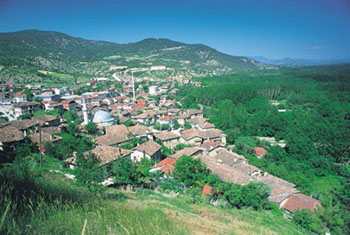|
|
|
|
|
 Taraklı is
a town in northwestern Turkey which was once a halting place on the Silk RoadIts venerable
history goes back to antiquity, when it was known variously as Dablies, Doris, Dablis and
Dablia. During Byzantine times, it was a small fortress town in the region governed by the
lord of Bursa. Taraklı was conquered by the Ottomans in 1331-1332 during the reign of
Orhan Gazi, and came to be known as Taraklı Yenicesi or Tarakçı Yenicesi. It was razed
by Timur's armies in the late 14th century, but rebuilt during the reign of Sultan Çelebi
Mehmed (1413-1421). In the 17th century the Ottoman writer Evliya Çelebi recorded, Taraklı is
a town in northwestern Turkey which was once a halting place on the Silk RoadIts venerable
history goes back to antiquity, when it was known variously as Dablies, Doris, Dablis and
Dablia. During Byzantine times, it was a small fortress town in the region governed by the
lord of Bursa. Taraklı was conquered by the Ottomans in 1331-1332 during the reign of
Orhan Gazi, and came to be known as Taraklı Yenicesi or Tarakçı Yenicesi. It was razed
by Timur's armies in the late 14th century, but rebuilt during the reign of Sultan Çelebi
Mehmed (1413-1421). In the 17th century the Ottoman writer Evliya Çelebi recorded,
As well as the highest peak of Uludağ Tepe, the mountain has several other peaks, including Zirvetepe, Kuşaklıkaya and Şahinkaya. At around 2000 metres there are moraines of loose rock and boulders deposited by glaciers, and the lakes of Kilimligöl, Karagöl and Aynalıgöl. The variation in climatic conditions from the lower slopes up to the peaks of Uludağ is the main factor in its considerable biological diversity. With over a hundred endemic species of flora, nearly thirty of them unique to Uludağ, the mountain is botanically one of the most interesting areas in the country. As the snow gradually recedes in spring, the mountain breaks out in color. Crocus biflorus, a pale lilac-blue crocus with two flowers to a stem, and Crocus chrysanthus, a golden yellow species, do not even wait for the snow to melt. Their flower heads on delicate stalks push their way through the snow cover. The wooden two storey houses have bay windows and bracket struts, stained glass windows and recesses known as eyvans decorated with naïve landscapes in the corners. Taraklı is 60 kilometres from Adapazarı and 135 kilometres from Istanbul. Just before Taraklı we turned off at Hacı Yakuplar to see the Kil Hamams (Turkish baths). We first visited two ruined hamams, named Gelin Yutan and Gıcık, that were still in use until the end of the 19th century according to local people. With their arches and pools, the hamams are thought to have been built at the halting place for the caravans carrying goods from Baghdad to Bursa. The Kil Hamam itself a kilometer further on is still in use, fed by natural hot springs. This water is good for rheumatism, arthritis, gynaecological complaints, skin complaints and some internal diseases, so people come here in large numbers for cures, particularly in the summer months. The water has a temperature of 49-50°.
Taraklı is a grade one conservation area whose historic houses up to three centuries old are under conservation and awaiting funds for their restoration. The cultural life of the town retains many of its old customs, the cuisine featuring many traditional dishes like keşkek (wheat and mutton purée), uğut (a dish made of coarsely ground flour), pekmez (grape molasses), and köpük helva. English apples grow only here, as do Göynük plums, which are not found in Göynük. In the past these foods were served at social gatherings known as ocakbaşı sohbeti and helva sohbeti. Although the craft of comb making which lent Taraklı its name has almost died out, spoon making is still thriving. The famous Taraklı spoons are made to hold exactly a mouthful, and continue to be preferred over metal spoons for eating by many local people.
Life in Taraklı's villages goes its peaceful way, untouched by time in many respects. But in the town itself you feel a sense of melancholy as you walk past the old houses, which resemble lonely but dignified old people with lined faces. In these deep wrinkles lie mingled memories of the past; of the Silk Road caravans, the Byzantines, the Ottomans, and the Turkish Republic. Their expression is tired, perhaps, but still proud.
|
| |
Our Hotel | Turkey | Cappadocia | Daily Tours | Views | Guestbook | Request Form | Home |